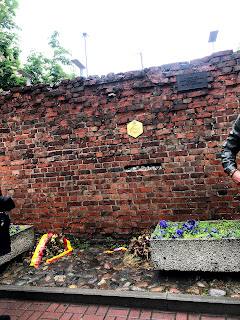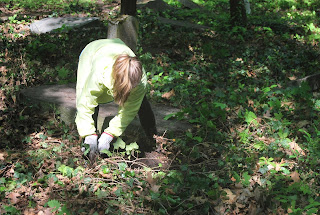We had a very busy day with lots of walking. We had a 7-hour (primarily walking) tour. We went to Plaszow, Schindler's Factory, the Jewish quarter, a cemetery/Synagogue, and finally Wawel Castle. In total today, I walked 7.5 miles all around Krakow so you could say my legs are pretty tired and my feet a little swollen.
 |
A memorial for all of the unmarked people
who were murdered here from 1942-1945 |
The guide we had for our 7-hour tour was very knowledgeable about Jewish history in Krakow and Poland and I think a lot of our group learned something new, whether it was something they already knew, but learned the meaning behind it, or simply something they had never been taught. For example, I knew about the tradition to place stones on the gravestone of someone who has passed, but I didn't know where it originated, or the reason for why flowers are never seen in Jewish cemeteries. I had a lot of different feelings at the Plaszow Concentration Camp. The number of prisoners, deaths, and atrocities that occurred there are incomprehensible, and with very little left, it was hard to even visualize the camp. It was almost completely destroyed; there are a few memorials and the roll call area that remain, the rest is a park with trails. I thought it was good that the place is being reborn in a way to be a beautiful place with trees and grass, but I saw someone going for a run, and I couldn't help but think it was odd.
Visiting Schindler's Factory and seeing the plaque that Albion college helped erect was very special and I felt very proud to be a Brit. It is always interesting to learn about what Albion has been a part of throughout the US and the world because our reach is a lot farther than our small community in the middle of Michigan. As we walked toward the Jewish quarter, we stopped at two spots used in the filming of Schindler's List, the ghetto housing/staircase that a young girl and her mother hid under and the area used as the ghetto square where registration and deportation happened.
 |
Plaque that Albion helped erect after the first
HSSLP trip (1999)
Albion is engraved at the very bottom |
 |
A part of the remaining ghetto wall - many times
were built by Jews in the ghetto as forced labor |
The ghetto of Krakow was very small and that area of town is very run down. We were able to see a few sites and even a small section of the ghetto wall that is still standing. From the ghetto area, we went to a 16th-century synagogue that had a cemetery connected to it. During the Second World War, both the Synagogue and the cemetery were completely gutted and treated with complete disregard from the German Nazis and needed to be completely restored. The cemetery was restored by Christians trying to help, and because of this, the cemetery is set up in very neat rows as a Christian cemetery would be. Inside the synagogue was small, but very very pretty. There were only plaques dedicated to the deaths of members of the community that remained in the synagogue after the German occupation.
 |
The ghetto square - the chairs are a memorial to all of
the Polish Jews that perished during the Holocaust |
 |
The stairwell that was used as a hiding
place in Schindler's List |
The very last stop of our tour was Wawel (pronounced Vavel) Castle. It was absolutely stunning and there is a lot of history behind it that we weren't able to talk much about because it would have taken another 7 hours! Our guide did mention that just before the Second World War broke out, the beautiful tapestries were sent to Canada in order to keep them out of the hands of the Nazis. Once the tour was completed, a few of us walked through the State's Rooms of the castle which was very cool. We weren't able to take pictures, unfortunately, but the tapestries that were sent away were stunning and massive. They ranged from biblical scenes to important battles in history. It's crazy to think that they were each stitched and are very old! The ceilings were all very interesting. Some had gold detailing, some had delicate biblical paintings, and one had wooden heads (unsure of the reason). There were huge cupboards and chests, very pretty stoves, and lots of gold detailed furniture
 |
| A street view of Wawel Caste |









Comments
Post a Comment